
In this article, we provide comprehensive information about the geography, history, population, and top tourist destinations of Delhi. Delhi is both a city and the national capital of India, located in the north-central part of the country. Delhi is home to iconic landmarks like the Red Fort, Qutub Minar, and India Gate, as well as vibrant markets such as Chandni Chowk and Connaught Place. The city reflects India’s diversity through its festivals, cuisine, and architecture, with influences from Mughal, British, and contemporary eras.
| About: | Delhi, officially known as the National Capital Territory (NCT) of Delhi, is both a city and a union territory in India, which includes New Delhi, the capital of the country. It is situated along the Yamuna River, primarily extending to the west, or beyond its right bank. Delhi shares its borders with Uttar Pradesh to the east and Haryana on the other sides. It was designated as a union territory on November 1, 1956, and became the NCT in 1995. The NCT spans an area of 1,484 square kilometers (573 square miles). According to the 2011 census, the population of Delhi proper exceeded 11 million, while the NCT’s total population was around 16.8 million. The urban agglomeration of Delhi, which encompasses satellite cities like Ghaziabad, Faridabad, Gurgaon, Noida, Greater Noida, and YEIDA city, is part of the National Capital Region (NCR) and has an estimated population of over 28 million, making it the largest metropolitan area in India and the second-largest in the world, following Tokyo. |
| History and Geography: | Delhi finds prominent reference right from the times of the epic Mahabharata. Its control passed from one ruler/dynasty to another, beginning with the Mauryas, Pallavas, Guptas of Central India, and then to the Turks and Afghan during the 13th to 15th centuries, and finally to the Mughals in the 16th century. In the latter half of the 18th century and early 19th century, the British rule was established in Delhi. In 1911, Delhi became the centre of all activities after the capital was shifted from Kolkata. It was made a Union Territory in 1956. Lying in the northern part of the country, Delhi is surrounded by Haryana on all sides except the east, where it borders with Uttar Pradesh. The 69th Constitutional amendment is a milestone in Delhi’s history, as it got a Legislative Assembly with the enactment of the National Capital Territory Act, 1991. |
| Industry: | Delhi is not only the largest commercial centre in northern India, but also the largest centre of small industries. These are Manufacturing a wide variety of items like television, tape recorders, Light Engineering Machines and automobile parts, sports goods, bicycles and PVC goods including footwear textiles, fertilizers, medicines, hosiery, leather goods, software, etc. Delhi’s new millennium industrial policy, emphasizes setting up of high-tech and sophisticated industries in electronics, telecommunications, software industries, IT enabling services, etc. The industries, which are non-polluting and encourage high value addition and depend largely on skilled manpower, are being promoted. DSIDC is setting up Training Institute for Gems and Jewellery and Assaying and Hallmarking Centre at Okhla in the building of Hitech Vocational Centre. |
| Agriculture: | The principal food crops are wheat, bajra, jowar, gram and maize. However, emphasis has now shifted from food crops to vegetables and fruit crops, dairy, poultry-farming, floriculture, etc., as these are more remunerative than food crops in the territory. |
| Country : | India |
| Region: | North India |
| Language: | Hindi & English (Official) |
| Population: | 21,588,000 (2024) |
| Literacy rate: | 86.21% (2011) |
| Major Attractions to Visit: | Jantar Mantar, New Delhi Parliament of India, New Delhi Red Fort (Lal Qila) India Gate Humayun’s Tomb Jama Masjid Akshardham Temple |





